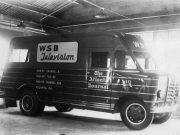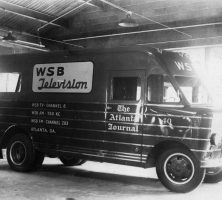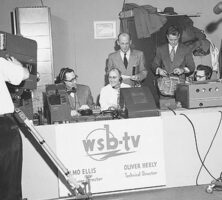On September 29, 1948, from a new building near Atlanta’s Peachtree Street, the first live commercial television program was broadcast in Georgia. Broadcasting on channel eight from the state’s tallest structure at the time, a tower higher than 800 feet, the television arm of WSB Radio and its parent, Cox Broadcasting, began regular service after years of planning and development. WSB-TV was the first television service in Georgia, as well as in the South.
Early Years of Television
The idea of sending pictures through the air existed for decades, but live television was not shown to the public until 1939 at the World’s Fair in New York City, where it was demonstrated by the Radio Corporation of America (RCA). The demands of World War II (1941-45) for equipment and talent would delay television from moving out of the communications center of New York City into Georgia and the rest of the South.
In 1931 WSB Radio applied for a license to broadcast television programs, but because there was no demand and because WSB did not have the needed equipment, the license was not issued. Although several stations in the New York City market began service in the early 1940s, Georgians didn’t see live television until after World War II.
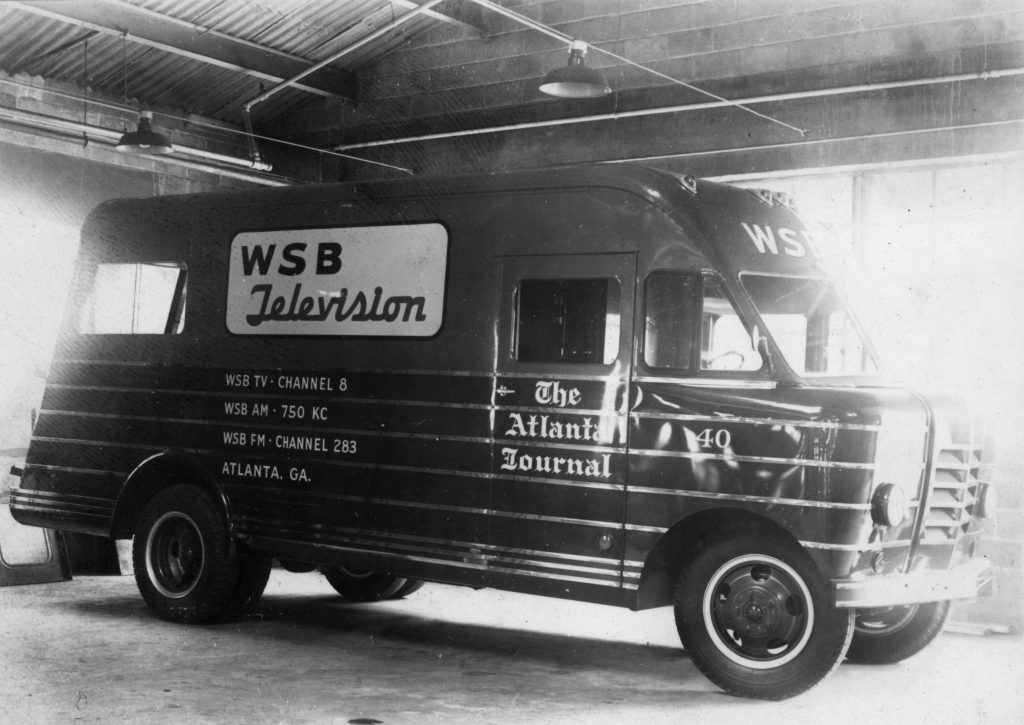
Courtesy of Special Collections & Archives, Georgia State University Library.
A great deal of money was required to initiate television service. An engineer at the time commented that he could put an entire small-market radio station on the air for the cost of just one television camera—not including lenses or a mounting dolly. Talent and expertise were not readily available for start-up operations, and to save money stations turned to established radio personalities. For example, the first official demonstration of television in the Southeast, at Rich’s Department Store in Atlanta in 1939, featured pianist and popular radio-show host Art Gillham, known as the “Whispering Pianist.”
Growth in Georgia
In part because of the expense, television service grew slowly in Georgia. Between 1948 and 1956 only fourteen commercial stations emerged in the state:
WSB-TV, Atlanta (1948)
WAGA-TV, Atlanta (1949)
WLTV (later WXIA), Atlanta (1951)
WROM-TV, Rome (1953) (became WTVC, Chattanooga, Tennessee, in 1958)
WMAZ-TV, Macon (1953)
WTVM, Columbus (1953)
WRBL-TV, Columbus (1953)
WJBF-TV, Augusta (1953)
WRDW-TV, Augusta (1954)
WTOC-TV, Savannah (1954)
WALB-TV, Albany (1954)
WATL, Atlanta (1954)
WCTV, Thomasville (1955)
WSAV-TV, Savannah (1956)
Georgia Public Broadcasting, an educational television station, was established in 1960 as Georgia Educational Television (ETV) at the University of Georgia in Athens. With the call letters WGTV, the station broadcast from a transmitter site atop Jack’s Creek Mountain near Monroe. Later it transmitted from atop Stone Mountain. In 1961 WXGA Waycross came on the air, followed in 1963 by WJSP Columbus and WVAN Savannah-Pembroke. By 1965 construction began on a state educational television network, control of which was vested in the state Board of Education. Television transmitters were erected in Chatsworth, Cochran, Dawson, Pelham, and Wrens.
A unique use of television was created by TV executive Elmo Ellis in 1949, when a bus driver strike shut down the Atlanta transit system and consequently hampered downtown commerce. WSB moved its cameras into Rich’s Department Store and created a daily program called Rich’s in Your Home. Thousands of dollars’ worth of merchandise was sold each day over the telephone as a result of the program. Rich’s maintained a bank of operators to take calls and fill orders, which were charged to customers’ store accounts and delivered through the mail.
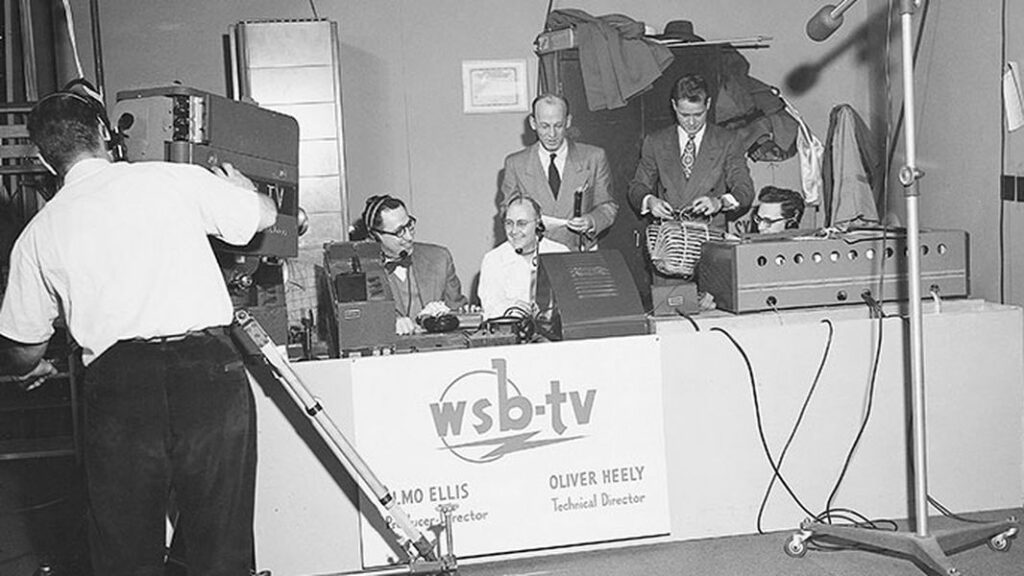
Courtesy of Atlanta Journal-Constitution.
Ted Turner’s Stations
Other broadcast innovations have earned recognition for Atlanta as one of the world’s television centers, alongside New York City; Chicago, Illinois; Los Angeles, California; London, England; Paris, France; and Rome, Italy. One such innovation came through Atlanta businessman Ted Turner, the founder of Turner Broadcasting System. Turner recognized the possibilities of ultrahigh frequency (UHF) channels, or the channels numbered fourteen through eighty-three. Prior to his success, few broadcasters ventured into the UHF channels, which require greater amounts of power to produce the same coverage as very-high frequency (VHF) channels, or channels two through thirteen. Moreover, most early television sets could not easily tune in the UHF channels.
Despite these difficulties, Turner saw a potential market, and in 1970 he bought a somewhat unsuccessful UHF station and renamed it “Superstation” WTBS. The new station utilized a previously unavailable technology, which transmitted the signal via satellite to cable systems all over the United States. Operating without benefit of a network, the “independent station” met with great success when Turner arranged unique programming. In addition to purchasing the entire MGM film library and thousands of reruns of popular television shows, he also bought the Atlanta Braves baseball team and the Atlanta Hawks basketball team and broadcast their games.
Turner’s vision opened the door for cable transmission systems to flourish inasmuch as they could now buy his specialized programming. In 1980 Turner launched CNN, the world’s first network to broadcast news twenty-four hours a day. The success of WTBS and CNN, both based in Atlanta, along with the growth of several VHF and other UHF stations in the market, made the city the nation’s ninth-largest television market in 2004. The influence of Turner’s stations brought Atlanta worldwide recognition and was arguably instrumental in establishing the city as a location suitable for the 1996 Olympics.
In addition to being home to major and influential broadcast networks, Georgia claims several nationally known television journalists and entertainers who began or spent part of their careers in the state, including Fred Briggs, Tom Brokaw, Joey Chen, Dick Van Dyke, Doug Edwards, Kenley Jones, Deborah Norville, John Palmer, Dave Riggs, Forrest Sawyer, and Judy Woodruff.


